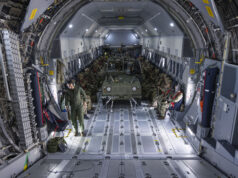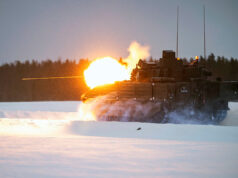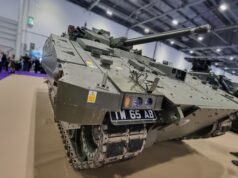The Ministry of Defence (MOD) has announced a £1 million contract award to Alford Technologies Ltd for the procurement of GLADIUS User-Filled Off-Route Mine systems.
The move aims to “mitigate a current capability gap in Lethal Barriers (mines)” and strengthen the British Army’s operational flexibility in defensive and offensive scenarios. The contract, awarded without prior publication due to proprietary considerations, will bolster NATO readiness and interoperability.
Bridging a Capability Gap
The GLADIUS system represents a reintroduction of anti-tank mine capability into the British Army, a vital measure for addressing current challenges in battlefield mobility and denial operations. According to the MOD’s notice, the system will provide “a means for defensive actions, offensive ambush and sabotage”, enabling the British military to respond effectively to evolving threats.
The MOD highlighted that the contract would support “training, capability development, and bolster NATO readiness” while ensuring interoperability with allied forces. The mines will also align with existing safety standards for in-service systems, minimising additional Defence Lines of Development (DLOD) impacts.
What Are GLADIUS Off-Route Mines?
The GLADIUS User-Filled Off-Route Mine system is a modern anti-tank mine designed for versatility and precision. Unlike traditional buried mines, off-route mines are deployed along paths to target the sides of armoured vehicles, exploiting their weaker points. Key features of the system include:
- User-Filled Design: The system allows operators to customise the explosive charge for specific mission requirements.
- Directional Lethality: Explosive force is focused in a particular direction, improving efficiency and minimising collateral damage.
- Remote Deployment: Operators can remotely detonate the mine at an optimal moment, increasing tactical flexibility.
- Mobility: These mines can be quickly deployed and retrieved, making them ideal for ambushes and mobile operations.
- NATO Interoperability: Already in use by 11 NATO nations, the system facilitates shared knowledge, training, and operational compatibility.
The GLADIUS system, say the MOD, enhances the British Army’s ability to deny enemy movement, create chokepoints, and conduct ambush operations against armoured vehicles.
Why Alford Technologies?
Alford Technologies Ltd, based in Newcastle upon Tyne, is the original equipment manufacturer (OEM) and intellectual property owner of the GLADIUS system. The MOD stated that “Alford is the only economic operator with the proprietary information to meet this requirement and meet MoD’s capability gap.”
The MOD justified the single-source procurement under the Defence and Security Public Contracts Regulations 2011, citing “technical challenges in maintaining and operating alternative systems.”
Operational Impact and NATO Integration
The inclusion of GLADIUS mines enhances NATO’s collective defence posture. With the system already in use by multiple NATO forces, the British Army benefits from “common spares, shared training opportunities, and streamlined operational practices.” This interoperability strengthens NATO’s ability to respond cohesively to threats, according to the notice.
The contract, valued at £1 million, is expected to be fulfilled within three months, depending on production timelines. While relatively small in monetary terms, this procurement represents a significant step in addressing the UK’s capability gap in lethal barriers.














It would appear that someone in DE&S is finally seeing sense.
Although £1million may seem a lot of money, in the big scheme of things, it is peanuts, and if it hadn’t gone straight to supplier, the MOD would have probably spent at least £500k drawing up tender documents etc etc, then spent 6 to 12 months for a review.
For once I am totally in agreement with the DE&S route to procuring this capabilty.
I worked for 2 years in DE&S; £1m is not a lot of money! My own small project was £60m.
This has all the makings of a good procurement.
It’s a small beginning. Perhaps, as it seems to be a weapon we can make, some extras should be ordered and sent to Ukraine?
who pays for all this stuff for Ukraine, the money comes from some where and as a nation we are skint. Paying for other peoples wars
If enemy tanks get across the channel then we’ll need anti tank mines, until then work on a mine barrage ost und sud.
Tanks are now drone fodder anyways, look at the Ostfront.
Make peace you idiots ❤️☮️
We are in nato
And why don’t you tell Russia to make peace ?
Make peace Russia you shower of imbeciles. Ukraine ain’t in Nato and ain’t got nukes.
Nato won’t mean schiesse once ww3 kicks off in earnest kid, you and I will be livin’ in a trench prayin’ for world peace, so I say this to all humanity’s warhawks.
Make peace you idiots 🫶✌️
Tell your boyfriend Putin to make peace, you moron!
TELL PUTIN THAT.
Putin make peace you f¥€£in’ imbecile, and every other leader and elitist German tanker.
That ok Geoff ?
🫶✌️
Russia’s the one that kicked all this off by invading Ukraine, you barely-literate, probably-inbred imbecile.
What are you talking about? We are at peace. Try telling Russia, theyre the ones at war.
Begun, the mine acquisition has. Combined with Finland potentially pulling out of the Oslo Accords, I can see this happening more
We should ne getting more mines both land ( and to be honest it should include anti personnel ones – if only to seed amonst anti armour – but the do gooders say no of course – pity Russians and Chinese etc don’t play by that rule book)…. and naval mines too as they are always a threat and relatively cheap for the problems they cause.
Are the mines eco friendly? Asking for a unicorn who farts rainbow dust.
I’m sure Ikea could sell their spare anti-tank mines in their warehouse.
Barmine was a good bit of kit
It was indeed, and with Ranger we could lay a mixed AP/AT minefield quicker than most other NATO armies. We need to get that capability back.
We had Shielder in service until some imbecile decided to remove it, no doubt to save a few million, losing the capability.
Is this as effective?
Daniele, I think Shielder was withdrawn because dumb AP scatterable mines were outlawed by the Ottawa Treaty.
Wiki is suggesting it is in service with Ukraine. no link to any thing to prove it though
Ah, ok. I thought the system deployed AT mines.
What?
Gave all ours away again did we.
Dave C, please see my answer. Dumb SM were banned.
I think, in addition to this, we should abandon our ban on cluster munitions and invest in a standoff cluster weapon.
Looking at the massed Russian convoys we saw at the beginning of the war, such a formation could easily be wiped out by a couple of planes carrying such weapons. This would be a significant force multiplier for our currently tiny forces.
Russian tank columns aren’t going anywhere any more. They can’t even get to Ukraine!
That’s very true now, but in 5-10 years? Who knows?!
I’d rather overestimate our enemy and then find out we’ve overprepared and kick the shit out of them, ala Gulf War 1991, than to underestimate them and then find ourselves in serious trouble.